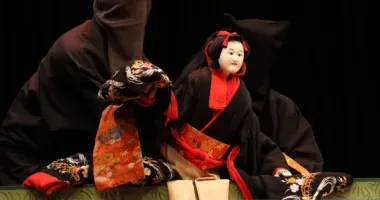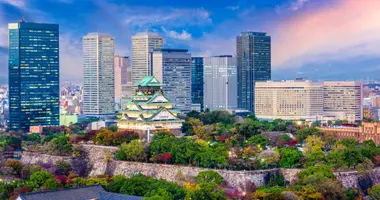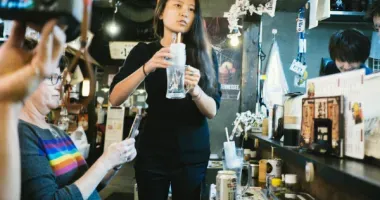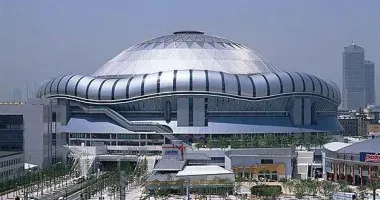Danjiri Festival Kishiwada Osaka
- Published on : 19/10/2016
- by : Japan Experience
- Youtube
Danjiri Festival: read a guide to the history and traditions of the Danjiri Festival in Kishiwada, south of Osaka.
Danjiri Festival, Kishiwada, Osaka 岸和田祭り
 Danjiri Festival, Kishiwada
Danjiri Festival, Kishiwada
At four o'clock the city of Kishiwada is still in darkness, but groups of men are gathered at one or another warehouse in different areas of the city. I am with the group from Nakai-cho.
"First," they say, "we will go to the shrine."
Today is not the official beginning of the Danjiri Festival. That is tomorrow when the danjiri will enter a Buddhist temple. Today a Shinto priest gives the blessings. He prays for the safety of everyone who will attend.
Then each team (the brakemen, the riders on the roof, etc.) rises separately to be blessed. Their expressions are such solemn studies in loyalty and commitment that I think back to my visit to Kishiwada's Danjiri Kai Kan (Danjiri Museum) the day before. With retired danjiri, exhibits detailing their construction and the history of the festival, and a 3D film, it is the next best thing to being there.
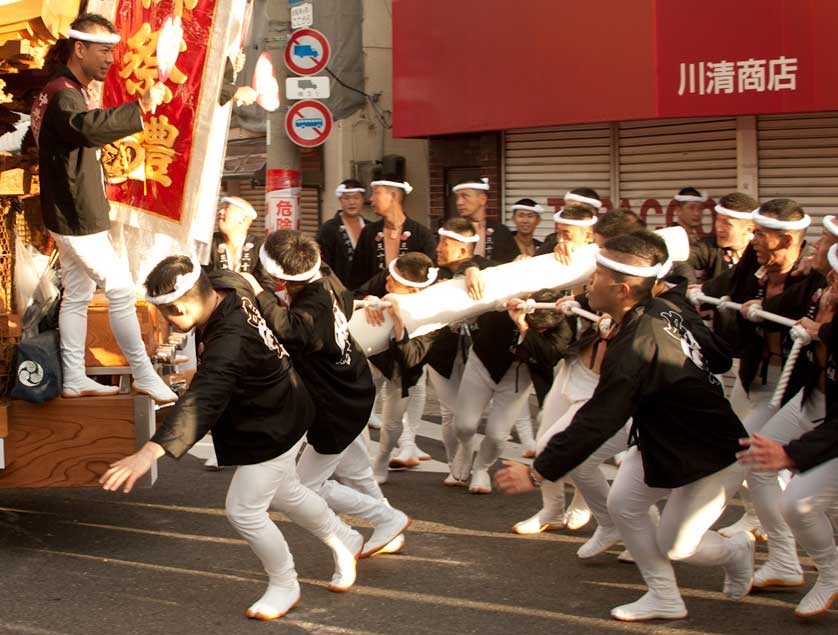 Danjiri Festival, Kishiwada
Danjiri Festival, Kishiwada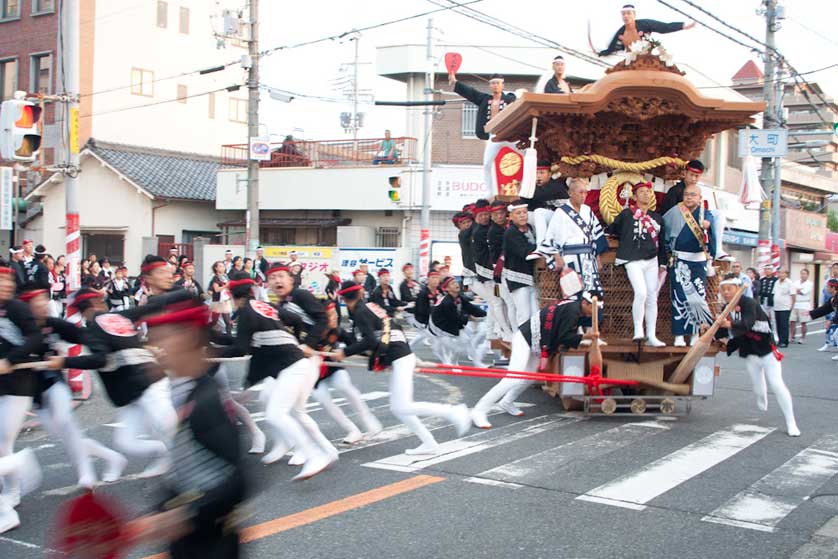 Danjiri Festival, Kishiwada
Danjiri Festival, Kishiwada
Danjiri
There I learned that a Danjiri is a wooden work of art that is roughly four meters tall, four meters long, and two and a half meters wide. A substantial framework is joined together without the use of fasteners. Then every centimeter is augmented with meticulous sculpture representing ancient myths or victorious battles. Its wheels are wide, wooden cylinders mounted directly onto the axles. They rotate as the danjiri moves, but cannot be turned to change direction. It weighs in the neighborhood of four tons.
Metal rings on the front are where a rope, long enough to accommodate between five hundred and one thousand people, is attached. A spar extending from the rear, to which several ropes are attached, is part of the steering mechanism.
Another part is the traditional braking system: two wooden poles carved into round handles on one end, and squared sections that are shaped on one side to match the curve of the wheels, on the other.
Each is operated by one man who inserts the pole at the front of the danjiri and uses various techniques to slow or stop the wheels on one side. Most have an inner compartment that accommodates three or four musicians who play a taiko drum, gong, and flute while the vehicle is being drawn through the streets.
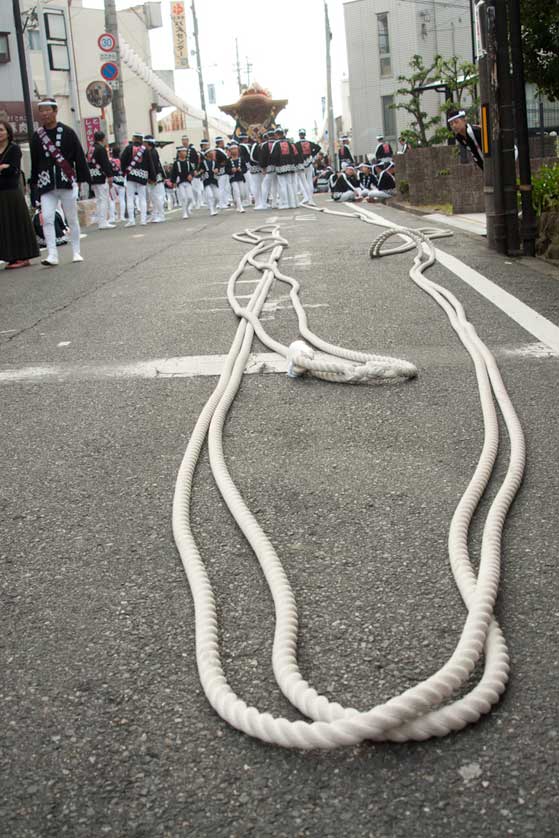 Danjiri Festival, Kishiwada
Danjiri Festival, Kishiwada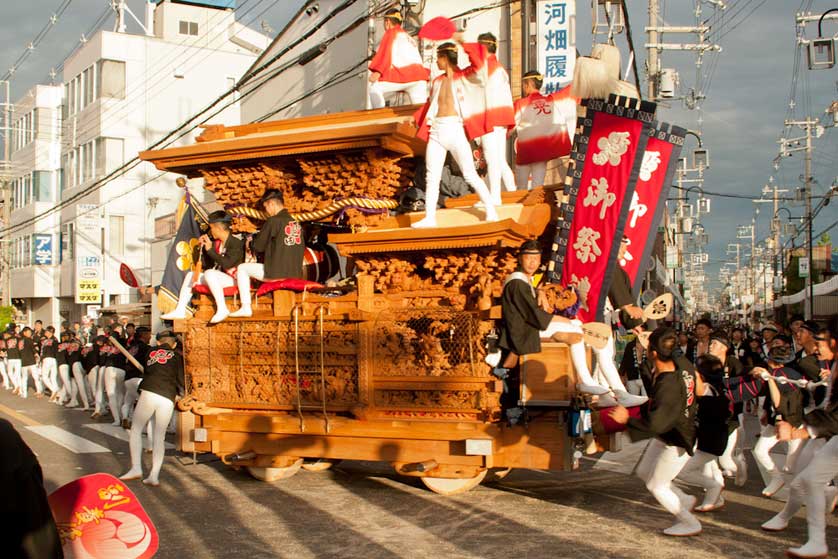 Danjiri Festival, Kishiwada
Danjiri Festival, Kishiwada
Origins of the Danjiri Festival
My guide explained that the festival had humble beginnings as a harvest ritual, showing me a model of an unadorned, rectangular cart from the early 18th century just large enough to hold a taiko and the village elder who would beat it as the cart was drawn to worship.
Since then, the festival has followed a course, nearly as complex as the paths the danjiri follow through the streets of the modern city, through 300 years of time. The idea for more ornate vehicles, as well as the themes for the carvings, came originally from China.
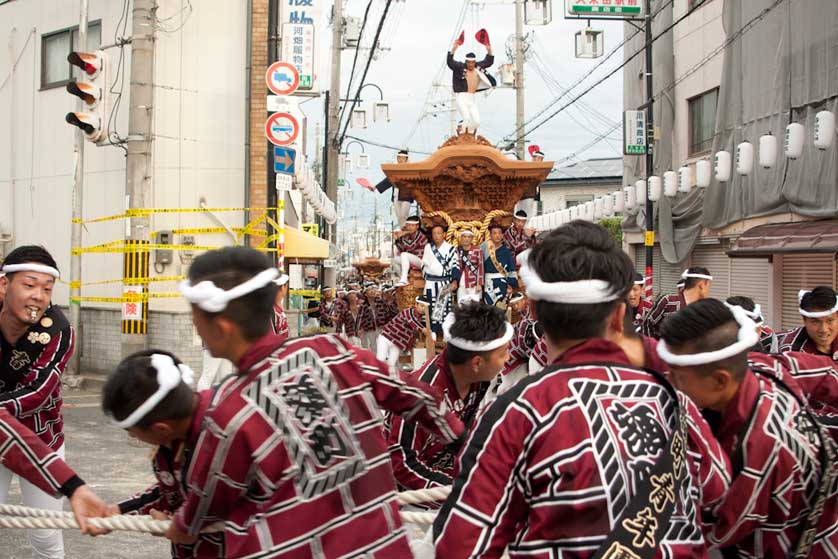 Danjiri Festival, Kishiwada, Osaka
Danjiri Festival, Kishiwada, Osaka
Up until World War II all the danjiri teams were exclusively male. The dearth of men during war time lead to the inclusion of women into the "engine" of pullers. Nowadays, in order that the festival shall be handed down through future generations, those of virtually all ages and both sexes may participate, although it is still only men who may ride the danjiri.
I asked my guide, since there are danjiri festivals all over Japan, why Kishiwada's eclipses all others in the minds of many Japanese. She explained that historically Kishiwada's Danjiri Festival came the earliest in the year, making it easy for many people to attend, increasing its popularity. "So," I wondered aloud, "as more people came did they pull the danjiri faster and faster to make it more exciting?"
With a disapproving, little frown she explained that safety was always the first priority in the festival. She had already pointed out the ridges built into the danjiri roofs where men dance and the special shoes they wear, as well as the only major part of the danjiri that is made of metal - an emergency braking system that includes the axles and a foot pedal that can be operated by one of the elders who ride at the front. "But," she added with a reluctant nod, "yes, it's true."
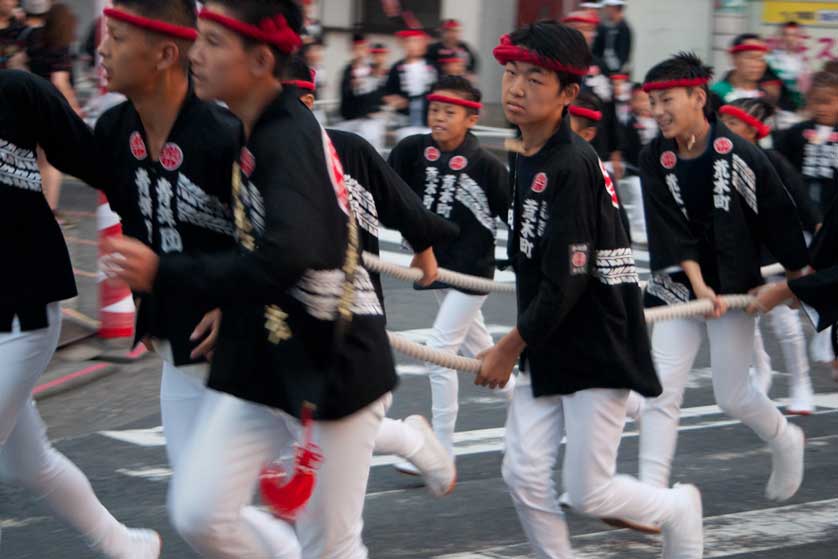 Danjiri Festival, Kishiwada, Osaka
Danjiri Festival, Kishiwada, Osaka
Pulling the Danjiri
This morning there is no reluctance in the faces of the proud men dressed all in white with happi coats bearing the symbol of Nakai-cho. Tomorrow, when I sit down to draft this article, I will hear the news of a Kishiwada man who died from being crushed between a danjiri and a guard rail. But today their smiles return as they depart the shrine and, after stopping for a quick breakfast of rice balls and miso soup - some indulge in a little beer - they return to the warehouse where the danjiri waits and ready for the Hiki-dashi (opening pull).
The teams of men board the danjiri, or surround it to clear its path. The engine of boys and girls is assembled. The ropes are extended. The elders address the crowd. Their message is simple: We must preserve this tradition, so let's make the next two days a great festival. The ropes draw taught. The craft wobbles a bit as it moves slowly down the uneven pavement in the predawn. At an intersection the engine steps into high gear, a neat turn onto the highway is executed, and the danjiri speeds smoothly away into the dark.
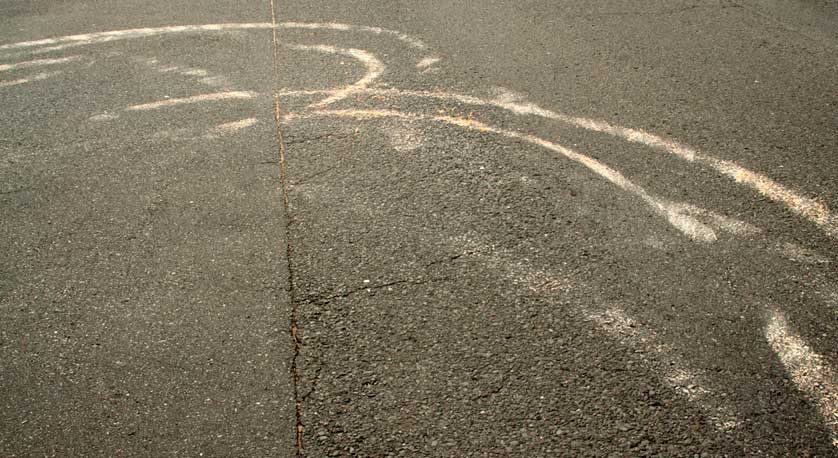 Sawdust marks in the road, Danjiri Festival, Kishiwada, Osaka
Sawdust marks in the road, Danjiri Festival, Kishiwada, Osaka
Guidebooks make much of the excitement in a danjiri turning a corner at incredible speed. I am more impressed with the skill involved. Speed is one factor in a simple equation that anyone with a driver's license should know: The higher the speed, the lower the traction. Since the wheels cannot turn they must skid to bring the vehicle through an arc.
Once a danjiri has passed a corner, you can see sawdust ground from the wheels into the pavement. (Both the wheels and the brake poles are replaced at intervals.) But this is precision skidding. The men on the roof, using signals given with uchiwa fans, coordinate the pullers and brakemen in the front with the people steering in the back to bring about what might be called a "Goldilocks turn." Fast enough to bring it through the angle, but not so fast that it will topple over.
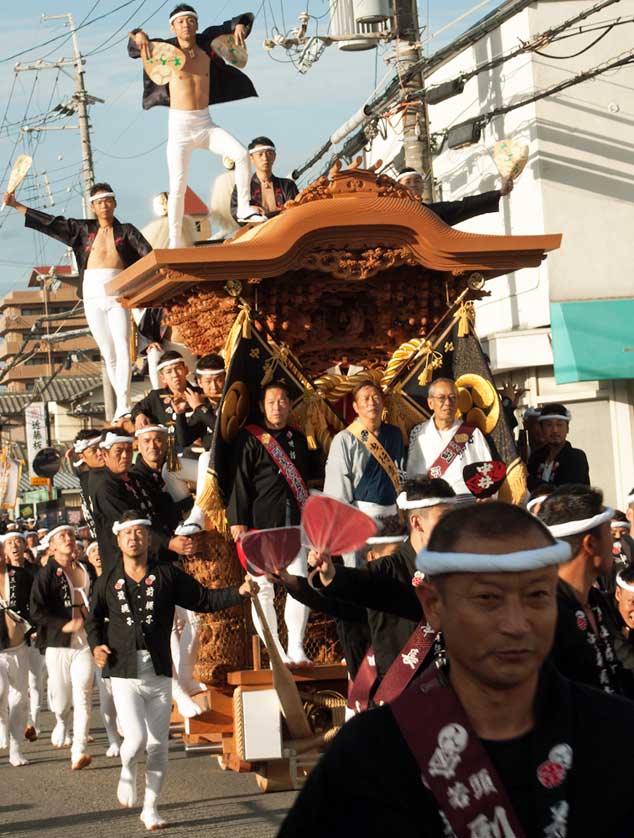 Danjiri Festival, Kishiwada, Osaka
Danjiri Festival, Kishiwada, Osaka
As the sun rises a number of danjiri begin weaving through the city streets and another sort of journey comes to light. The youngest children are at the front of the engine, the older ones closer to the vehicle, both in front and in back. The musicians are mostly adolescents, the dancers on the roof are young men. In mid-life one steps off the danjiri to clear the way or operate the breaks until the twilight years when one may reboard up front and perhaps watch the grandchildren pull the danjiri into the future.
Kishiwada holds annual, danjiri festivals in September and October. Dates, locations, and schedules can be found at the official website: www.city.kishiwada.osaka.jp/site/danjiri (Official site in Japanese and other languages)
Danjiri Festival Video
Osaka Festivals
The Tenjin Fesival is one of Japan's big three festivals.
Read more about Osaka's Festivals.
